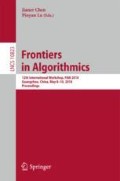Abstract
A binary matrix M has the consecutive ones property (C1P) for rows (resp. columns) if there is a permutation of its columns (resp. rows) that arranges the ones consecutively in all the rows (resp. columns). If M has the C1P for rows and the C1P for columns, then M is said to have the simultaneous consecutive ones property (SC1P). We focus on the classical complexity and fixed parameter tractability of Simultaneous Consecutive Ones Submatrix (SC1S) and Simultaneous Consecutive Ones Editing (SC1E) [1] problems here. SC1S problems focus on deleting a minimum number of rows, columns and rows as well as columns to establish the SC1P whereas SC1E problems deal with flipping a minimum number of 1-entries, 0-entries and 0-entries as well as 1-entries to obtain the SC1P. We show that the decision versions of the SC1S and SC1E problems are NP-complete. We consider the parameterized versions of the SC1S and SC1E problems with d, being the solution size, as the parameter and are defined as follows. Given a binary matrix M and a positive integer d, d-SC1S-R (d-SC1S-C) problem decides whether there exists a set of rows (columns) of size at most d whose deletion results in a matrix with the SC1P. The d-SC1S-RC problem decides whether there exists a set of rows as well as columns of size at most d whose deletion results in a matrix with the SC1P. The d-SC1P-0E (d-SC1P-1E) problem decides whether there exists a set of 0-entries (1-entries) of size at most d whose flipping results in a matrix with the SC1P. The d-SC1P-01E problem decides whether there exists a set of 0-entries as well as 1-entries of size at most d whose flipping results in a matrix with the SC1P. Using a related result from the literature [2], we show that d-SC1P-0E on general binary matrices is fixed-parameter tractable with a run time of \(O^{*}(45.5625^{d})\). We also give FPT algorithms for SC1S and SC1E problems on certain restricted binary matrices.
Access this chapter
Tax calculation will be finalised at checkout
Purchases are for personal use only
References
Oswald, M., Reinelt, G.: The simultaneous consecutive ones problem. Theoret. Comput. Sci. 410(21–23), 1986–1992 (2009)
Kaplan, H., Shamir, R., Tarjan, R.E.: Tractability of parameterized completion problems on chordal, strongly chordal, and proper interval graphs. SIAM J. Comput. 28(5), 1906–1922 (1999)
Tucker, A.: A structure theorem for the consecutive 1’s property. J. Comb. Theory Ser. B 12(2), 153–162 (1972)
Fishburn, P.C.: Interval orders and interval graphs. Discret. Math. 55(2), 135–149 (1985)
Oswald, M.: Weighted consecutive ones problems. Ph.D. thesis (2003)
König, R., Schramm, G., Oswald, M., Seitz, H., Sager, S., Zapatka, M., Reinelt, G., Eils, R.: Discovering functional gene expression patterns in the metabolic network of escherichia coli with wavelets transforms. BMC Bioinform. 7(1), 119 (2006)
Fulkerson, D., Gross, O.: Incidence matrices and interval graphs. Pac. J. Math. 15(3), 835–855 (1965)
Booth, K.S., Lueker, G.S.: Testing for the consecutive ones property, interval graphs, and graph planarity using PQ-tree algorithms. J. Comput. Syst. Sci. 13(3), 335–379 (1976)
Hsu, W.L.: A simple test for the consecutive ones property. J. Algorithms 43(1), 1–16 (2002)
Hsu, W.L., McConnell, R.M.: PC trees and circular-ones arrangements. Theoret. Comput. Sci. 296(1), 99–116 (2003)
McConnell, R.M.: A certifying algorithm for the consecutive-ones property. In: Proceedings of 15th Annual ACM-SIAM Symposium on Discrete Algorithms, pp. 768–777. Society for Industrial and Applied Mathematics (2004)
Meidanis, J., Porto, O., Telles, G.P.: On the consecutive ones property. Discret. Appl. Math. 88(1–3), 325–354 (1998)
Raffinot, M.: Consecutive ones property testing: cut or swap. In: Löwe, B., Normann, D., Soskov, I., Soskova, A. (eds.) CiE 2011. LNCS, vol. 6735, pp. 239–249. Springer, Heidelberg (2011). https://doi.org/10.1007/978-3-642-21875-0_25
Downey, R.G., Fellows, M.R.: Fundamentals of Parameterized Complexity, vol. 4. Springer, London (2013). https://doi.org/10.1007/978-1-4471-5559-1
Dom, M.: Recognition, Generation, and Application of Binary Matrices with the Consecutive Ones Property. Cuvillier, Gottingen (2009)
van’t Hof, P., Villanger, Y.: Proper interval vertex deletion. Algorithmica 65(4), 845–867 (2013)
West, D.B.: Introduction to Graph Theory, vol. 2. Prentice Hall, Upper Saddle River (2009)
Uno, T., Satoh, H.: An efficient algorithm for enumerating chordless cycles and chordless paths. In: Džeroski, S., Panov, P., Kocev, D., Todorovski, L. (eds.) DS 2014. LNCS (LNAI), vol. 8777, pp. 313–324. Springer, Cham (2014). https://doi.org/10.1007/978-3-319-11812-3_27
Stirling, J.: Methodus differentialis, sive tractatus de summation et interpolation serierum infinitarium, London. The Differential Method: A Treatise of the Summation and Interpolation of Infinite Series (1730). (Trans. by, J. Holliday)[1749](1730)
Yannakakis, M.: Node-and edge-deletion NP-complete problems. In: Proceedings of 10th Annual ACM Symposium on Theory of Computing, pp. 253–264. ACM (1978)
Yannakakis, M.: Node-deletion problems on bipartite graphs. SIAM J. Comput. 10(2), 310–327 (1981)
Natanzon, A., Shamir, R., Sharan, R.: Complexity classification of some edge modification problems. Discret. Appl. Math. 113(1), 109–128 (2001)
Yannakakis, M.: Computing the minimum fill-in is NP-complete. SIAM J. Algebr. Discret. Methods 2(1), 77–79 (1981)
Drange, P.G., Dregi, M.S., Lokshtanov, D., Sullivan, B.D.: On the threshold of intractability. In: Bansal, N., Finocchi, I. (eds.) ESA 2015. LNCS, vol. 9294, pp. 411–423. Springer, Heidelberg (2015). https://doi.org/10.1007/978-3-662-48350-3_35
Author information
Authors and Affiliations
Corresponding authors
Editor information
Editors and Affiliations
Rights and permissions
Copyright information
© 2018 Springer International Publishing AG, part of Springer Nature
About this paper
Cite this paper
Rani, M.R., Jagalmohanan, M., Subashini, R. (2018). Classical Complexity and Fixed-Parameter Tractability of Simultaneous Consecutive Ones Submatrix & Editing Problems. In: Chen, J., Lu, P. (eds) Frontiers in Algorithmics. FAW 2018. Lecture Notes in Computer Science(), vol 10823. Springer, Cham. https://doi.org/10.1007/978-3-319-78455-7_12
Download citation
DOI: https://doi.org/10.1007/978-3-319-78455-7_12
Published:
Publisher Name: Springer, Cham
Print ISBN: 978-3-319-78454-0
Online ISBN: 978-3-319-78455-7
eBook Packages: Computer ScienceComputer Science (R0)

